Chengyin Hu
Multi-View Black-Box Physical Attacks on Infrared Pedestrian Detectors Using Adversarial Infrared Grid
Jul 01, 2024Abstract:While extensive research exists on physical adversarial attacks within the visible spectrum, studies on such techniques in the infrared spectrum are limited. Infrared object detectors are vital in modern technological applications but are susceptible to adversarial attacks, posing significant security threats. Previous studies using physical perturbations like light bulb arrays and aerogels for white-box attacks, or hot and cold patches for black-box attacks, have proven impractical or limited in multi-view support. To address these issues, we propose the Adversarial Infrared Grid (AdvGrid), which models perturbations in a grid format and uses a genetic algorithm for black-box optimization. These perturbations are cyclically applied to various parts of a pedestrian's clothing to facilitate multi-view black-box physical attacks on infrared pedestrian detectors. Extensive experiments validate AdvGrid's effectiveness, stealthiness, and robustness. The method achieves attack success rates of 80.00\% in digital environments and 91.86\% in physical environments, outperforming baseline methods. Additionally, the average attack success rate exceeds 50\% against mainstream detectors, demonstrating AdvGrid's robustness. Our analyses include ablation studies, transfer attacks, and adversarial defenses, confirming the method's superiority.
Adversarial Infrared Curves: An Attack on Infrared Pedestrian Detectors in the Physical World
Dec 21, 2023



Abstract:Deep neural network security is a persistent concern, with considerable research on visible light physical attacks but limited exploration in the infrared domain. Existing approaches, like white-box infrared attacks using bulb boards and QR suits, lack realism and stealthiness. Meanwhile, black-box methods with cold and hot patches often struggle to ensure robustness. To bridge these gaps, we propose Adversarial Infrared Curves (AdvIC). Using Particle Swarm Optimization, we optimize two Bezier curves and employ cold patches in the physical realm to introduce perturbations, creating infrared curve patterns for physical sample generation. Our extensive experiments confirm AdvIC's effectiveness, achieving 94.8\% and 67.2\% attack success rates for digital and physical attacks, respectively. Stealthiness is demonstrated through a comparative analysis, and robustness assessments reveal AdvIC's superiority over baseline methods. When deployed against diverse advanced detectors, AdvIC achieves an average attack success rate of 76.8\%, emphasizing its robust nature. we explore adversarial defense strategies against AdvIC and examine its impact under various defense mechanisms. Given AdvIC's substantial security implications for real-world vision-based applications, urgent attention and mitigation efforts are warranted.
Two-stage optimized unified adversarial patch for attacking visible-infrared cross-modal detectors in the physical world
Dec 04, 2023



Abstract:Currently, many studies have addressed security concerns related to visible and infrared detectors independently. In practical scenarios, utilizing cross-modal detectors for tasks proves more reliable than relying on single-modal detectors. Despite this, there is a lack of comprehensive security evaluations for cross-modal detectors. While existing research has explored the feasibility of attacks against cross-modal detectors, the implementation of a robust attack remains unaddressed. This work introduces the Two-stage Optimized Unified Adversarial Patch (TOUAP) designed for performing attacks against visible-infrared cross-modal detectors in real-world, black-box settings. The TOUAP employs a two-stage optimization process: firstly, PSO optimizes an irregular polygonal infrared patch to attack the infrared detector; secondly, the color QR code is optimized, and the shape information of the infrared patch from the first stage is used as a mask. The resulting irregular polygon visible modal patch executes an attack on the visible detector. Through extensive experiments conducted in both digital and physical environments, we validate the effectiveness and robustness of the proposed method. As the TOUAP surpasses baseline performance, we advocate for its widespread attention.
Impact of Light and Shadow on Robustness of Deep Neural Networks
May 23, 2023Abstract:Deep neural networks (DNNs) have made remarkable strides in various computer vision tasks, including image classification, segmentation, and object detection. However, recent research has revealed a vulnerability in advanced DNNs when faced with deliberate manipulations of input data, known as adversarial attacks. Moreover, the accuracy of DNNs is heavily influenced by the distribution of the training dataset. Distortions or perturbations in the color space of input images can introduce out-of-distribution data, resulting in misclassification. In this work, we propose a brightness-variation dataset, which incorporates 24 distinct brightness levels for each image within a subset of ImageNet. This dataset enables us to simulate the effects of light and shadow on the images, so as is to investigate the impact of light and shadow on the performance of DNNs. In our study, we conduct experiments using several state-of-the-art DNN architectures on the aforementioned dataset. Through our analysis, we discover a noteworthy positive correlation between the brightness levels and the loss of accuracy in DNNs. Furthermore, we assess the effectiveness of recently proposed robust training techniques and strategies, including AugMix, Revisit, and Free Normalizer, using the ResNet50 architecture on our brightness-variation dataset. Our experimental results demonstrate that these techniques can enhance the robustness of DNNs against brightness variation, leading to improved performance when dealing with images exhibiting varying brightness levels.
Fooling Thermal Infrared Detectors in Physical World
Apr 21, 2023Abstract:Infrared imaging systems have a vast array of potential applications in pedestrian detection and autonomous driving, and their safety performance is of great concern. However, few studies have explored the safety of infrared imaging systems in real-world settings. Previous research has used physical perturbations such as small bulbs and thermal "QR codes" to attack infrared imaging detectors, but such methods are highly visible and lack stealthiness. Other researchers have used hot and cold blocks to deceive infrared imaging detectors, but this method is limited in its ability to execute attacks from various angles. To address these shortcomings, we propose a novel physical attack called adversarial infrared blocks (AdvIB). By optimizing the physical parameters of the adversarial infrared blocks, this method can execute a stealthy black-box attack on thermal imaging system from various angles. We evaluate the proposed method based on its effectiveness, stealthiness, and robustness. Our physical tests show that the proposed method achieves a success rate of over 80% under most distance and angle conditions, validating its effectiveness. For stealthiness, our method involves attaching the adversarial infrared block to the inside of clothing, enhancing its stealthiness. Additionally, we test the proposed method on advanced detectors, and experimental results demonstrate an average attack success rate of 51.2%, proving its robustness. Overall, our proposed AdvIB method offers a promising avenue for conducting stealthy, effective and robust black-box attacks on thermal imaging system, with potential implications for real-world safety and security applications.
Catoptric Light can be Dangerous: Effective Physical-World Attack by Natural Phenomenon
Sep 19, 2022



Abstract:Deep neural networks (DNNs) have achieved great success in many tasks. Therefore, it is crucial to evaluate the robustness of advanced DNNs. The traditional methods use stickers as physical perturbations to fool the classifiers, which is difficult to achieve stealthiness and there exists printing loss. Some new types of physical attacks use light beam to perform attacks (e.g., laser, projector), whose optical patterns are artificial rather than natural. In this work, we study a new type of physical attack, called adversarial catoptric light (AdvCL), in which adversarial perturbations are generated by common natural phenomena, catoptric light, to achieve stealthy and naturalistic adversarial attacks against advanced DNNs in physical environments. Carefully designed experiments demonstrate the effectiveness of the proposed method in simulated and real-world environments. The attack success rate is 94.90% in a subset of ImageNet and 83.50% in the real-world environment. We also discuss some of AdvCL's transferability and defense strategy against this attack.
Adversarial Color Projection: A Projector-Based Physical Attack to DNNs
Sep 19, 2022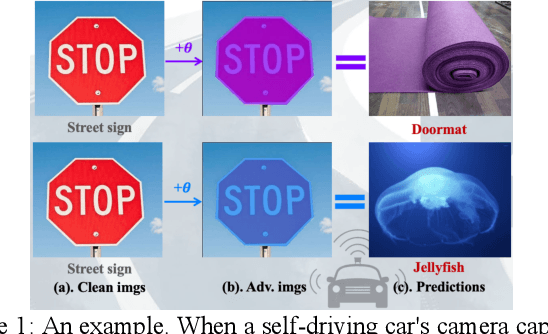
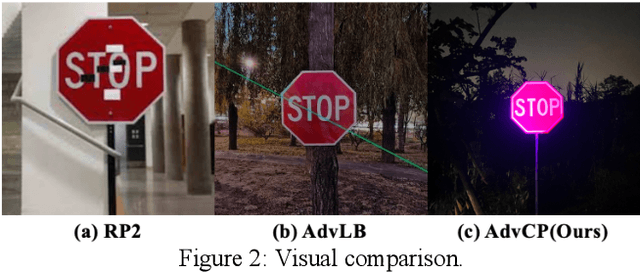
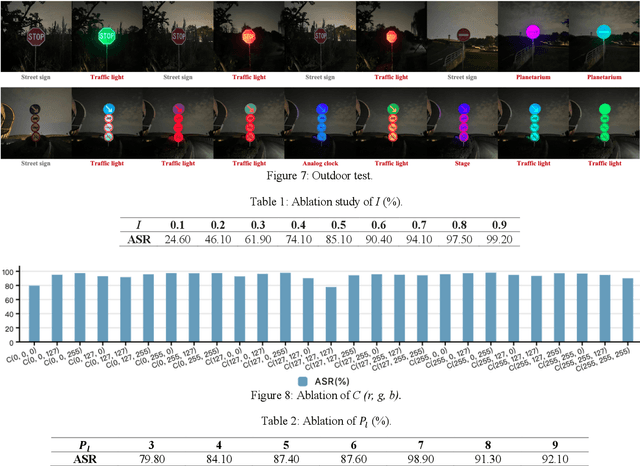

Abstract:Recent advances have shown that deep neural networks (DNNs) are susceptible to adversarial perturbations. Therefore, it is necessary to evaluate the robustness of advanced DNNs using adversarial attacks. However, traditional physical attacks that use stickers as perturbations are more vulnerable than recent light-based physical attacks. In this work, we propose a projector-based physical attack called adversarial color projection (AdvCP), which performs an adversarial attack by manipulating the physical parameters of the projected light. Experiments show the effectiveness of our method in both digital and physical environments. The experimental results demonstrate that the proposed method has excellent attack transferability, which endows AdvCP with effective blackbox attack. We prospect AdvCP threats to future vision-based systems and applications and propose some ideas for light-based physical attacks.
Adversarial Color Film: Effective Physical-World Attack to DNNs
Sep 02, 2022



Abstract:It is well known that the performance of deep neural networks (DNNs) is susceptible to subtle interference. So far, camera-based physical adversarial attacks haven't gotten much attention, but it is the vacancy of physical attack. In this paper, we propose a simple and efficient camera-based physical attack called Adversarial Color Film (AdvCF), which manipulates the physical parameters of color film to perform attacks. Carefully designed experiments show the effectiveness of the proposed method in both digital and physical environments. In addition, experimental results show that the adversarial samples generated by AdvCF have excellent performance in attack transferability, which enables AdvCF effective black-box attacks. At the same time, we give the guidance of defense against AdvCF by means of adversarial training. Finally, we look into AdvCF's threat to future vision-based systems and propose some promising mentality for camera-based physical attacks.
Impact of Colour Variation on Robustness of Deep Neural Networks
Sep 02, 2022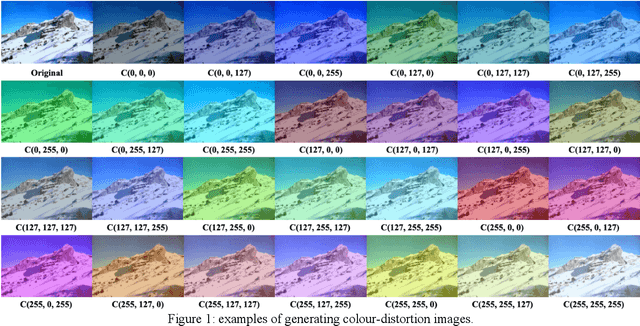
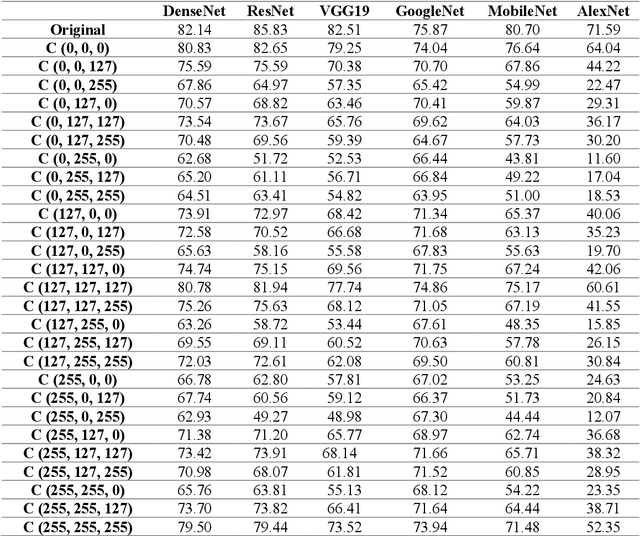

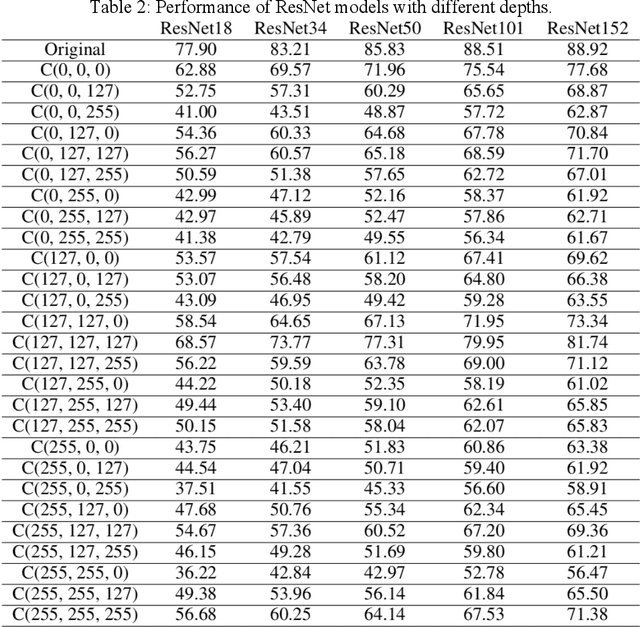
Abstract:Deep neural networks (DNNs) have have shown state-of-the-art performance for computer vision applications like image classification, segmentation and object detection. Whereas recent advances have shown their vulnerability to manual digital perturbations in the input data, namely adversarial attacks. The accuracy of the networks is significantly affected by the data distribution of their training dataset. Distortions or perturbations on color space of input images generates out-of-distribution data, which make networks more likely to misclassify them. In this work, we propose a color-variation dataset by distorting their RGB color on a subset of the ImageNet with 27 different combinations. The aim of our work is to study the impact of color variation on the performance of DNNs. We perform experiments on several state-of-the-art DNN architectures on the proposed dataset, and the result shows a significant correlation between color variation and loss of accuracy. Furthermore, based on the ResNet50 architecture, we demonstrate some experiments of the performance of recently proposed robust training techniques and strategies, such as Augmix, revisit, and free normalizer, on our proposed dataset. Experimental results indicate that these robust training techniques can improve the robustness of deep networks to color variation.
Impact of Scaled Image on Robustness of Deep Neural Networks
Sep 02, 2022



Abstract:Deep neural networks (DNNs) have been widely used in computer vision tasks like image classification, object detection and segmentation. Whereas recent studies have shown their vulnerability to manual digital perturbations or distortion in the input images. The accuracy of the networks is remarkably influenced by the data distribution of their training dataset. Scaling the raw images creates out-of-distribution data, which makes it a possible adversarial attack to fool the networks. In this work, we propose a Scaling-distortion dataset ImageNet-CS by Scaling a subset of the ImageNet Challenge dataset by different multiples. The aim of our work is to study the impact of scaled images on the performance of advanced DNNs. We perform experiments on several state-of-the-art deep neural network architectures on the proposed ImageNet-CS, and the results show a significant positive correlation between scaling size and accuracy decline. Moreover, based on ResNet50 architecture, we demonstrate some tests on the performance of recent proposed robust training techniques and strategies like Augmix, Revisiting and Normalizer Free on our proposed ImageNet-CS. Experiment results have shown that these robust training techniques can improve networks' robustness to scaling transformation.
 Add to Chrome
Add to Chrome Add to Firefox
Add to Firefox Add to Edge
Add to Edge